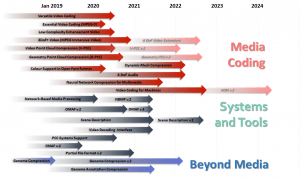Some readers of this blog may not remember – or be aware of what was – the world of media standards before MPEG came to the fore. Thirty years ago competences were scattered in ISO, IEC and ITU in ways that may appear illogical today but responded to the logic “I and my industry peers gather in one place and develop standards for our own needs”. For instance, there was a committee in charge of audio recording, another for cinematography and yet another for telephony speech, not to say about photography, set top boxes and more. You can get a complete picture here.
The logic driving the licensing of the necessary technology was a consequence of this mindset. A company that had developed and marketed a successful product would bring the specification to the appropriate committee, get a stamp on it and license the technology to all companies wishing to practice the standard. As everybody “spoke the same language” the licence would naturally be configured in the way all practicing entities would expect it to be.
Then came MPEG and all these committees either disappeared or got reconfigured. The scenario of many committees developing “many vertical media standards” was replaced by a single committee – MPEG – developing “single horizontal media standards”.
Of course, after a quarter of century of technology and (partly) industry convergence, no one would think of creating standards for such old-style “verticals”.
The fact that the MPEG-2 standard served the specific digital television industry and that most patent holders would actually practise it explains how it was possible to create the MPEG-2 Video (and Systems) technology and license it to those digital television users.
Problems started to appear some 20 years ago after MPEG-4 Visual (ISO/IEC 14496-2). The licence developed for that standard charged those streaming MPEG-4 Visual content for the duration of content streamed. The “IT industry” refused those licensing terms because they did not suit their business model. In response to this void a number of companies offered – with alternate fortunes – video streaming and other IT services.
The MPEG-4 AVC standard (ISO/IEC 14496-10) fared definitely better because the AVC licence corrected the terms considered most outrageous by the IT industry while still satisfying the needs of the broadcasting and consumer electronics industries.
In hindsight we should have expected that the licensing of the HEVC technology would find the difficulties we know. More than 15 years after MPEG-4 Visual and AVC, digital video is a technology used by many disparate industries. Still we are not back to the time of vertical standards as 30 years ago because the roles of the industries are now mapped to the layers of an ISO/OSI (or equivalent) model, not to separate non-communicating mutually agnostic silos.
The business models of the different industries generate different needs but in MPEG they are forced to develop standards according to a single business model imposed by the ISO/IEC/ITU patent policy. Here is a concise and incomplete summary of it (for ISO/IEC)
- Companies who believe they have Intellectual Property (IP) in an ISO/IEC standard should file a declaration with the ISO and IEC secretariats declaring their intention to license their IP for free (Option 1), FRAND (Option 2) or not license it at all (Option 3);
- IP holders are not required to identify the patents and the specific claims in the patents;
- ISO/IEC do not take position on those declarations but simply record them;
- Committees developing standards are not allowed to assess patent declarations, they have to comply with them;
- Licensing of ISO/IEC standards shall be developed outside ISO/IEC.
I believe that item 5 of the patent policy should remain untouched and so should probably be items 4 and 3. But item 2 prevents MPEG from taking corrective measures if ISO/IEC receive an Option 2 patent declaration against a standard that is intended to be “royalty free” or an Option 3 declaration against a standard that is intended to be FRAND, if the declarations fail to identify the claimed infringed technology.
ISO/IEC should allow the development of international standards that satisfy a business model that a committee freely adopts. This requires that the committee should have the means to remove patents from a standard that a third party does not wish to be used in support of the committee’s business model.
I do not have to say that a committee that adopts a business model is not developing a licence. Indeed we are simply recreating the situation of 30 years ago when each committee operated according to the shared business models of the industries populating it.
Posts in this thread (in bold this post)
- The MPEG ecosystem
- Why is MPEG successful?
- MPEG can also be green
- The life of an MPEG standard
- Genome is digital, and can be compressed
- Compression standards and quality go hand in hand
- Digging deeper in the MPEG work
- MPEG communicates
- How does MPEG actually work?
- Life inside MPEG
- Data Compression Technologies – A FAQ
- It worked twice and will work again
- Compression standards for the data industries
- 30 years of MPEG, and counting?
- The MPEG machine is ready to start (again)
- IP counting or revenue counting?
- Business model based ISO/IEC standards
- Can MPEG overcome its Video “crisis”?
- A crisis, the causes and a solution
- Compression – the technology for the digital age
- On my Charles F. Jenkins Lifetime Achievement Award
- Standards for the present and the future

